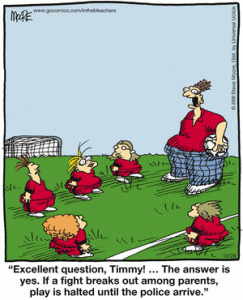Momentum
 The scientific formula for momentum
The scientific formula for momentum
M x V = P Mass (m) x velocity (v) = Momentum (p)
The formula for momentum is Newtons Second Law and states that mass (which means you) plus velocity equals momentum.
I’ve always been fascinated by the laws of nature, and have seen firsthand when they’re applied what radical changes they’ve created in the gym, in business and every area of life.
The law of momentum states that the faster something is moving—whether it be a car, a gymnast or any moving object or thing (like your business), the harder it is to stop.
Momentum also goes hand in hand with personal productivity. Momentum allows you to make the most of your time and create exceptional results you would have great difficulty to achieve without it.
Using the formula for momentum for business success:
If you consider the term “momentum” outside of the world of physics and instead apply it to the business world, you could take the example of someone who starts their own business:
In the beginning you will be putting in daily effort, coaching, answering phones, teaching classes, and cleaning bathrooms. Doing various tasks in the first few days, weeks or months that will show little result. BUT, BOY, WILL YOU BE ABLE TO TELL IF YOU DON’T DO THESE THINGS. Keep doing these things and momentum will grow.
There is always resistance when you’re doing something new and if you start but then take your foot off the gas, you stall creation and won’t reap the immense rewards momentum gives you! For your gym to have momentum, some force needs to set it in motion(your daily actions), and that force needs to be applied over a period of time (consistency) which then guarantees excellent results (if you do highly effective activities and actually work instead of surfing or wasting your time).
It’s also your approach, not your identity that will decide how difficult or quickly you will gain momentum. I have seen coach/ club owners spend more time on their logo or name of their gym than on the content of their program.
Below is a simple formula for momentum that you can use to create exponential results in your business in minimal time:
1. Identify your Goals. Plan clear goals and decide to make it happen. It doesn’t matter if you’ve struggled for years before. What do you want in YOUR gym? Anything is possible and your only limitations are those you place on yourself. Your goals need to be Clear, Concise and Measurable. You should have both SHORT and LONG TERM goals.
2. Identify your Strengths: Identifying your strengths is a key secret to success. When you do, your work will be much more enjoyable, your progress will be much faster and you will get momentum you can easily retain. Working in your weaknesses is like working with a handicap.
3. Systemize Everything: Create a 90 day plan, with a daily method of operation and stick to it no matter what (most people start strong and with the first obstacle or difficulty fizzle out). Analyze which EXACT steps you will take each day and what the most effective tasks are to propel your business forward. You don’t need to know everything when you begin. Pick 1 core strategy and master it (before adding other things) until you’ve gained momentum and you’re consistently getting the results you want.
“If you can’t describe what you’re doing as a process you don’t know what you’re doing” – Edward Demming
4. Start a Tribe: This is one of the most incredible ways to speed up your momentum. By joining together with like minded individuals who share the same vision and help each other, you leverage not only the efforts of a great team but you’ll be able to accomplish things you could never do alone! In the gym there will be no “Dad says NO, I’ll go ask Mom.” In the office you need someone who is as invested in the program as you are.
5. Be Consistent: Being consistent is one of the most powerful and crucial elements to success in any area of life. It’s what sets you apart from the rest and is way more important than moments of occasional greatness or intense bursts of genius! Almost everything in life can be learned, achieved and acquired through consistent focused action and it’s the main reason anyone gains momentum.
6. Get Metrics: Find a way to track exactly what you’re doing in your business and the results you are getting from each activity you do. Even if when you begin you use the method of testing and trying and failing forward fast, running a business without metrics is like driving a car with your eyes closed.
Many people think motivation leads to action, but the reverse is actually true — action precedes motivation. Getting momentum initially might seems difficult (like losing bad habits or instilling good ones), but with a little discipline and follow through, momentum comes and miracles happen!
Full disclosure- I found most of this info from another source while surfing the web at a coffee shop. For some reason- I CAN NOT find that web page any more!
Nutritional Tips for Coaches
Nutritional Tips for Coaches
Gina Paulhus, CPT and Owner, HOMEBODIES FITNESS TRAINING
As a coach, chances are you work during the hours the average person sits down for a meal–in many cases, it’s ‘dinner’ that you miss. Working through a major meal can throw off your eating habits and wreak havoc on your attempts at keeping a healthy lifestyle.
Eating the right foods consistently throughout the day is the best weapon we have to keep our energy levels and our health in order. Once nutrition starts to slide, it’s just a matter of time before it catches up with us. The following 10 tips will give you some ideas on how you might improve your eating habits which will carry over into you performing better and having more energy at work and in your personal life. You will also set a good example for your athletes.
#1 Eat breakfast. This one is an oldie but goody. We’ve all heard it, but tons of people STILL don’t eat something within an hour or waking up, and it’s a huge mistake. If you don’t have a huge appetite in the morning, have something small that contains protein such as a yogurt, a protein shake or a hard boiled egg. You can always have a snack later on, but you don’t want to wait until lunch to eat. Just don’t do it.
#2 Have healthy snacks on hand at home, in your car and in the office at work at all times. The biggest reason people choose the wrong foods is because they find themselves hungry and there is nothing else convenient to eat. 100-calorie packs of nuts, fruit such as bananas, apples and clementines, or whole food bars made with nuts and dried fruit are good choices. If you have a refrigerator, yogurt, string cheese, and veggies with hummus are good snacks.
#3 Have a plan for lunch. If you’re working during lunch, the best is to bring lunch from home. You can also bring a healthy microwave meal. If you are going to get take-out, have a few go-to meals you can order out that you know are healthy, and stick to that list. Don’t wait until you are ravenous to eat lunch—you will make poor choices. Make extra dinner the night before, and save a portion for lunch the next day. If you go to work after lunch, try to make lunch the biggest meal of the day to hold you over.
#4 Drink tons of water ALL day. This is another oldie but goody. Water is even more important than food for our health and energy levels. There is no getting around the need for, in general, 64 ounces of pure water each day. Count how many times you fill up your water bottle and make sure you’re getting enough. This will also help control your appetite.
#5 Managing the late dinner. Most coaches regularly deal with having to eat a late dinner. While not ideal from a digestion standpoint, eating late is not the end of the world as long as your total calorie intake for the day is not excessive. However, the main problem with a late dinner is that people get so hungry waiting for a late dinner that the end up overeating. Try to have a snack that contains fiber such as a piece of fruit or a whole food bar around 6pm when the average person would be eating dinner, and fill up at least 50% of your dinner plate with vegetables. Eat those first and you will not eat as much of the higher calorie items. You will also ensure you get adequate nutrients since vegetables are the most nutritious part of the diet.
#6 Use a day off or a lighter work day as a chance to get ahead with you food planning for the week. Make sure you get that grocery shopping in, and try to cook some meals ahead of time and keep them in the refrigerator or freezer. You will be so glad you did on one of those 12+ hour days when you barely have time to brush your teeth.
#7 Don’t let your caffeine habit get out of hand. We all rely on coffee from time to time to get us through. However, using caffeine habitually creates a vicious cycle of energy problems because it can interfere with our sleep, which makes us more tired in the end. Caffeine also tends to cause an energy surge followed by a crash, which can lead you toward more caffeine or snacks you really don’t need. It’s best to keep coffee to the morning. In the afternoon and evening, if you need a boost, tea contains a gentler source of caffeine that won’t tend to keep you up at night, and it also contains healthful antioxidants.
#8 Sugar is the enemy. If you do one thing, look out for added sugars in your diet. Sugar is the worst thing you can put into your body, and just keeping tabs on that will make a ton of difference. Many packaged foods contain a surprising amount of added sugar—read labels!
#9 Go organic whenever possible. Your food is only as good as your body can process and use it, and organic food is much more nutritious. You will eat less and get more out of organic food—it’s worth the extra money when you can get it.
#10 Don’t beat yourself up if you make a poor choice. We all do from time to time—the important thing is to get right back on the bandwagon at your next meal or snack.
Have something you want to share? Keep the MOMENTUM going- SHARE
On Sportsmanship for Gymnasts, Coaches and Parents
SPORTSMANSHIP
On the long drive home after a very successful weekend at an Invitational my coaches and I had an opportunity to reflect on the behavior of some coaches, parents and gymnasts. We were in agreement that sportsmanship is really something NOT addressed enough in our sport. It came down to that there are some coach/club owners who allow such behavior out of parents from their gym that it becomes an embarrassment to the sport itself. Many of these same coaches are so focused on the score that they do not see an exemplary performance. These coaches are often the “Bad Winners”.
To get good at winning, you have to get good at losing.
The bottom line is that you or your team is NOT going to win every competition you go to. All winning streaks come to an end. When I first started coaching, my goal was to have each gymnast, and therefore, each team competitive at each level. I knew we weren’t going to have a lot of 1st place team trophies but we were going to have a good product on the floor. As my team grew and my coaching staff improved we started winning more, but my goal was the same. To be competitive. I made sure that every gymnast, coach and parent knew this.
To the Gymnasts: If you have a good meet and someone has a better meet, congratulate them. Appreciate their hard work and determination. It is OK to want to beat the competition, but beat them on their BEST day. If you have a bad meet (and you will), get over it, get back to the gym and get to work. I have seen so many gymnasts not be able to recover from a bad event or a bad meet. Move on. Read my post on Failure, A Prerequisite for Success.
To the Coaches: Practice the 6 P’s. Proper Planning Prevents Piss Poor Performance. If you plan and Prepare your gymnasts in practice then your job in the meet should be easier. You can not control the competition and you can not control the score. If you go to a meet and get your butt kicked, congratulate that team. As difficult as it is, try to catch some great performances from other teams.
To the Parents: Keep in mind, you never know whose parents or grandparents you may be sitting next to. Say NOTHING negative. Appreciate a good routine regardless of what color leotard that child has on. During awards, clap for every place whether 1st place or 101st place. In the team competition, be respectful. Cheer for every place. If your team wins- Be happy but try not to be over the top with your cheering.
The following is a letter I sent out to parents from my gym following the last competition.
Parents,
There is no way I can possibly tell you how proud we are of your children. Not just for their performance in the meet but for their composure, and sportsmanship they displayed. In every meet, someone is going to have a good meet and others are going to struggle. Athletes at both ends of the spectrum handled their individual situations with poise and dignity. They cheered for their team mates, they cheered for other competitors. During awards they were respectful of the competition, they were showed real class. This is one thing as coaches we expect of your children at competitions and we are so happy that they acted accordingly.
At FAR TOO MANY competitions, we have seen and heard groups of parents that cheered and acted like they were at a football game. It is always awkward when a team of parents is cheering for “their team” to the point of being obnoxious. I am so happy that this has NEVER been a parent from Atlantic. We really dominated this competition at every level and age group. During the competition I heard many of you applaud for a good performance regardless of what color leotard that gymnast had on. During awards I heard you cheer for every place from top to bottom.
As I left the meet and went over to thank the Meet Director, John, and his brother Gene (the guy giving out awards) they congratulated Atlantic as a team for having a good weekend and then commented on what a classy group of parents we had. We shared a few stories of parents from other gyms who are not as gracious guests and really are an embarrassment to the sport as a whole.
For being such great parents and teaching your kids such great values I THANK YOU. I AM PROUD.
Tony
I’M A GYMNAST
Thanks to the gymnasts from E.N.A in Paramus, NJ for sharing this video. I am sure that The GYM MOMENTUM website is just their first step to Americas Got Talent.
[Read more…]
Top 8 Strength Training Moves for Coaches
Top 8 Strength Training Moves for Coaches
Gina Paulhus
President/CEO, Home Bodies
www.homeexercisecoach.com
Coaches have HUGE muscle imbalance because 90% of the time spent in the gym is spent PUSHING so there is a lot of triceps work compared to relatively small biceps work. Over time, this can lead to injuries and pain, both chronic and acute. In the weight training gym with your own workout, you want to accomplish three things:
- Strengthen your large muscle groups so you can keep your metabolism up, and also so that you have the overall strength to coach and spot.
- Improve your core strength so that all of your muscles work together and your back stays protected
- Work to balance out muscle imbalances that come from spotting.
The following routine will accomplish all three points. The routine actually doesn’t require a gym at all, but rather can be performed at home with simply a spot on the floor, a chair and a set of dumbbells. Of course, if you have kids, pets or a spouse who won’t leave you alone, you might be better off heading to the gym to get it done anyway.
It’s best to perform them in the order listed because the initial exercises serve as a good warmup for the following exercises. It’s best to elevate your heart rate and body temperature with 5-10 minutes of brisk walking or jogging before beginning this routine. Stretching if performed should happen at the end of the workout.
1: SQUATS
How to Start: Stand with feet turned out and slightly wider than shoulder width. Hold a dumbbell to your chest. The weight might be anything from 5 lb. to 50 lb. or more depending on your strength. You want to choose the heaviest weight you can handle keeping good form.
Action: Keeping your chest up, bend your legs until your hips get to approximately knee level. Think of sitting back in a chair. Knees should not drift beyond toes. To accomplish this–really stick your butt back. Sometimes I actually put a chair behind the squatter so there is a visual to aim for.
Do this many: 12-15 reps for 2 sets. Rest 30 seconds between sets.
2: BENT-OVER ROW
How to start: Place your hand on a chair and move your feet back until your back is approximately parallel to the ground or slightly angled upward. Keep a slight arch in your back. In your other hand, hold a weight. You might start with anything from a 10 lb. to a 30 lb. or more depending on your strength.
Action: Keeping your core tight so that your torso stays still, pull the weight to your side until it touches your body. Your hand should end up around your lower ribcage. Make sure your elbow stays close in to your body. Think of pinching your shoulder blades together and make sure your wrist stays straight.
Do this many: 15 reps on each side for 3 sets. Do not rest between arms, but rest between sets about 30 seconds. Always start with your weaker side.
3. OVERHEAD SHOULDER PRESS
How to start: Standing up with one hand on your waist, hold a dumbbell just above your other shoulder to the side of your head. Engage your core so that you are standing up straight to start. A 5 lb. to 25 lb. weight might be appropriate to start.
Action: Think of stretching to the ceiling as you push the weight overhead. You will feel your core engaging to keep your balance. This is good! Make sure the weight stays directly to the side of your head and not in front. If you experience shoulder pain you don’t have to bend the elbow down as low.
Do this many: 10-15 reps on each side for 1 set. Always start with your weaker side. (Insert pictures)
4. SINGLE LEG CALF RAISE
How to start: Standing on one leg with the other foot wrapped around the first leg, allow your heel to hang off the side of an object such as a stair.
Action: Allow your heel to sink as long as it will go keeping your standing leg straight. Pause for 1 full second, then press your body up, concentrating on pressing through your big toe the most. Pause for 1 full second at the top. That is one rep.
Do this many: 20 repetitions for one set on each side.
5. HAMMER CURLS
How to start: Stand straight up with both shoulders even. Hold a dumbbell like you would a ‘hammer’ with palm facing in to your body. Start with between a 10 lb. and 25 lb. weight.
Action: Engage core so that your torso stays still and your shoulders stay even. Curl the arm with the weight so that the end of the weight touches your shoulder.
Do this many: 15 reps on each side for 2 sets. You do not need to rest between any of the sets (you might WANT to rest, but you do not NEED to rest—there is a difference!!!
6. ONE-LEG STIFF LEG DEADLIFT
How to start: Balancing on one leg, hold a weight in your hand on the same side as the leg you’re balancing on. Squeeze your butt and pick a spot on the floor 4 feet in front of you. Stare at that spot. It will help you balance. Your standing leg should remain slightly bent throughout this exercise. A 10 to 25 lb. weight is a good place to start.
Action: Lift your free leg behind you to counterbalance as you bend over. Keep the dumbbell close to your shin. Stop when the dumbbell is just above the floor. Dig your heel into the floor to help yourself stand back up again. Avoid touching your free leg to the floor. ***IF this is hard for you, have some sympathy when you train your gymnasts on the beam or pommel horse!!!***
Do this many: 12 on each leg for 2 sets. Do not rest between legs, but rest 1 full minute between sets. Always start on your weaker side.
7. DIPS
How to start: Place your hands on the edge of a chair with fingers off the edge. Scoot your butt forward so you are clearing the chair. This exercise can be performed with legs straight (more advanced) or legs bent (easier).
Action: Bend your arms to lower your butt toward the floor. Bend as far as your flexibility allows. Make sure your elbows are pointing straight back.
Do this many: 15 to 20 for 1 set.
8. ACROSS BICEP CURL
How to start: Stand holding a dumbbell in one hand. Be sure your core is engaged and shoulders are even. A 10 to 15 lb. weight is a good place to start for this exercise.
Action: Curl the weight toward the OPPOSITE shoulder. Then lower your arm back down to its place.
Do this many: 15 reps on each arm for 2 sets. Don’t rest between arms or between sets. Always start with your weaker side.
This routine takes about 20 minutes to perform. It exercises all of the muscles in the entire body, with an emphasis on evening out muscle imbalances common to those who coach gymnastics. Because it is a full body weight training routine, it also blasts calories and fat, helping you control your body weight and build or maintain muscle mass. Your metabolism will be elevated for about 48 hours after completing this routine, and your odds of incurring a back or shoulder injury while spotting is dramatically reduced.
*Be sure to check with your doctor that you are physically cleared to begin an exercise program.
Shoulder PRE-HAB for Coaches
Shoulder Pre-hab for Coaches
Gina Paulhus, President/CEO, Home Bodies
The shoulder is an unstable joint that is easily injured. No one wants to get hit in the face, and you want kids to have room to pirouette and twist so as coaches we tend to hold (or catch) a great deal of weight away from our body. Obviously a mechanical disadvantage but it is still better than getting punched in the face!
This six-exercise routine will help keep your shoulders healthy. Perform it three times a week and you’ll see your ability to withstand the forces during spotting and come out at the end of the day pain-free. If you already have shoulder problems please consult a doctor or a physical therapist before performing this routine.*
1: LYING ROTATOR CUFF

How to Start: Lie do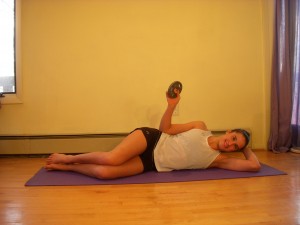 wn on your side with your top elbow set at your lower ribcage. Hold a weight across your belly button.
wn on your side with your top elbow set at your lower ribcage. Hold a weight across your belly button.
Action: Keeping your elbow stationary, rotate your arm so that weight moves up above your body. Bring the weight as far back as possible keeping good form. You should feel the muscles behind your shoulder working. Think of pinching your shoulder blades together as you perform the exercise.
Do this many: 12-15 reps for 2 sets. A 2.5 lb. weight is a good place to start for most.
2: I, T, Y on FLOOR
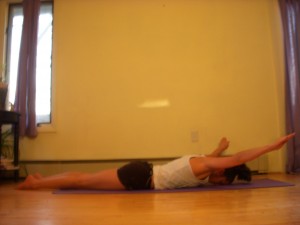
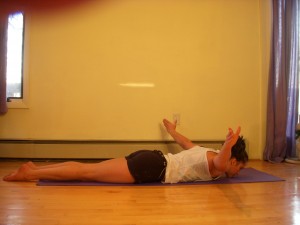
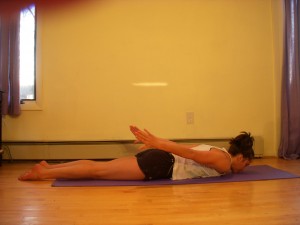
How to start: Lie facedown on a mat with arms down by hips, palms facing up. Arms remain completely straight for this entire exercise. Head remains touching the mat the entire exercise (is your mat clean??)
Action: For the ‘I’, raise your arms off the floor as far as possible by pinching the shoulder blades together. If you use your imagination your body looks like the capital letter ‘I.’ For the ‘T’, move your arms out to the sides like the capital letter ‘T’ and raise them as far off the floor as possible. For the ‘T’ your thumbs face up. For the ‘Y’ move your arms diagonally overhead and raise them as far as possible. Palms face down for the ‘Y.’
Do this many: 8 ‘I’, followed by 8 ‘T’, followed by 8 ‘Y’. Each rep is held for 2 seconds.
3. BAND SQUEEZE

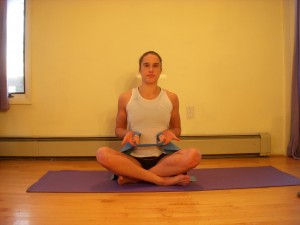
How to start: Sit on a mat with your spine straight. Hold a band at your lower ribcage right up against your body. Thumbs should face in and be anywhere from 2 inches apart to 6 inches apart depending on your strength and the tension of your band. You need the be able to pull the band apart.
Action: Pinch your shoulder blades together aggressively and rotate your thumbs outward. As you pull the band apart draw your elbows back and even closer to your body.
Do this many: 25 repetitions, each one held for 1 second.
4. BAND ROW

How to start: Sit up on the mat with a straight spine and legs extended. Wrap a band around your feet.
Action: Draw the elbows back until they are at your sides. Think of pulling your band with your back by pinching the shoulder blades rather than just pulling with your biceps. Keep straight through the wrist.
Do this many: 25 repetitions, each one held for 1 second.
5. SHOULDER ROLL
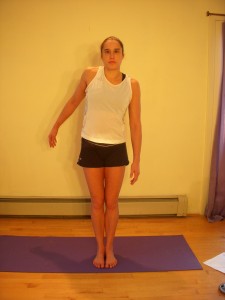
How to start: Stand straight up with both shoulders even.
Action: Pick one shoulder to start with. Perform a shoulder roll, first pulling the shoulder forward, then up and around to to the back, and finally back to the starting position. Once you have completed the reps for the backward roll, reverse the motion and perform a forward roll. Then switch sides.
Do this many: 10 slow shoulder rolls back followed by 10 slow shoulder rolls forward, followed by the other side.
6. SHOULDER SHRUGS OFF A CHAIR
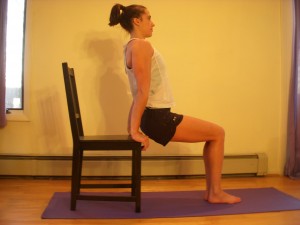

How to start: Position your hands off the edge of a chair that is about shoulder width or a little smaller. Knees are bent 90 degrees and your body should be able to just clear the chair.
Action: Keeping arms completely straight, allow your body to sink through the shoulder girdle. You might not have much range of motion, but this will improve over time. Once you have sunk as low as you can, press yourself up as high as you can to elongate your neck.
Do this many: 20 shrugs.
Perform this routine once though. It can be completed in ten minutes and your shoulders will be much more likely to stay healthy and strong no matter how many cast handstands you have to spot!
*Be sure to check with your doctor if you have back pain or pain in your abdominal muscles to ensure that it is safe for you to perform these exercises.
GYM MOMENTUM
“The minute that we lose momentum, we lose the thread.”
Jocelyn Glei
Gymnastics Education is just like Newton’s First Law of Motion: The tendency of a body in motion is to keep moving; the tendency of a body at rest is to sit still. In other words, it’s a lot less work to keep educating yourself and keep moving once you have some momentum, than it is to start moving from a dead stop.
If we can keep moving on our projects every day – stoking that creative fire regularly to keep the flames high – it’s infinitely easier to stay focused, make great strides, and blast through the roadblocks that inevitably come up.
That being said, everyone needs a push every once and a while. THAT’S WHERE GYM MOMENTUM COMES IN!
1. Know that momentum takes time to build.
It’s important to set small, realistic goals at first. Challenge yourself and your gymnasts, but don’t overdo it. Setting achievable goals, and experiencing incremental success will help you build momentum and confidence.
2. Carve out a consistent block of time to work on your education.
As Gymnastics coaches, we all wear very many hats. From head janitor to sports psychologist and team trainer. Finding regular time to devote to your education in a daily way can be extremely challenging. But there is nothing more important. Consistent education is paramount: it keeps your head clear and focused; it rewards you with a constant feeling of progress; and, most importantly, it keeps the ball moving forward.
3. Work on your education every day. No seriously, every day.
When it comes to momentum, frequency of execution is perhaps more important than the duration of execution. Even if you only have 3 minutes a day to work on your education you will at least keep moving forward. My goal is to NOT waste your time. I want to put real, usable drills and progressions up here.
4. Once you really get some momentum going, don’t be afraid.
Don’t hold back. When it comes to creative execution, the key is to get moving, and keep moving. THEN SHARE.
HAPPY NEW YEAR!
Wit and Wisdom- New Years Edition
“New Year’s eve is like every other night; there is no pause in the march of the universe, no breathless moment of silence among created things that the passage of another twelve months may be noted; and yet no man has quite the same thoughts this evening that come with the coming of darkness on other nights.” -Hamilton Wright Mabie
“May all your troubles last as long as your New Year’s resolutions!” Unknown
“New Year’s Resolution: To tolerate fools more gladly, provided this does not encourage them to take up more of my time.” James Agate
Top TEN of 2011
TOP TEN of 2011
1. 2011 Hall of Fame Ceremony. Robert Miller- Spirit of the Flame Award. A 5 minute standing ovation at Visa Championships that evening.
USA WOMEN WIN GOLD AT WORLD CHAMPIONSHIPSUSA
3. MEN WIN BRONZE AT WORLD CHAMPIONSHIPS
4. JORDYN WEIBER- WORLD CHAMPION
5. DANELL LEYVA- P.BAR GOLD MEDAL, (TIE )JOHN OROZCO 5th AA WORLD CHAMPIONSHIPS
6. MEN’S NCAA CHAMPIONS STAMFORD, WOMEN’S NCAA CHAMPIONS ALABAMA
7. “GRAND RE-OPENING” OF USA GYMNASTICS UNIVERSITY.
8. SUZY GOT HER KIP! Dedicated to everyone who got a new skill this year.
9. VISA CHAMPIONS Sr Men Danell Leyva, Sr Women Jordyn Weiber. Jr Men- Adrian de los Angeles, Jr Women Katelyn Ohashi
10. JO National Champions.
WOMEN
- JR A
- Alexandra McMurtry Richmond Olympiad, 38.575
- JR B
- 1T Elizabeth Gangale, Brown’s LV, 37.900
- 1T Bayle Pickel Twistars USA, 37.900
- JR C
- Katie Bailey High Point, 38.025
- JR D
- Charity Jones, Dynamo Gymnastics, 38.250
- SR A
- Asi Peko Brown’s LV, 38.400
- SR B
- Hollie Blanske Twin City Twisters, 38.450
- SR C
- Jessie DeZiel Twin City Twisters, 38.825
- SR D
- 1t Georgia Dabritz Ace, 38.300 (Utah)
- 1t Allison Flores IGI, 38.300
- MEN’S
- Level 10 16-18
- Adrian De Los Angeles (SCATS)
- Level 10 14-15
- Sean Melton (Orlando Metro)
- Level 9 (12-13 yr olds) All Around Top 10:
- Marty Strech (Azarian)

